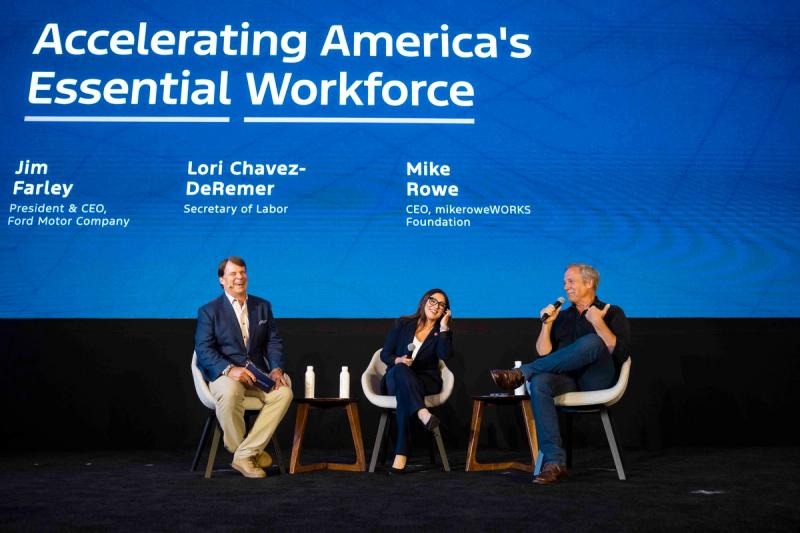The Signal Interview
Ford Motor CEO Jim Farley stood in front of a crowd in Detroit this week and said that if Henry Ford were alive today, “he’d be really upset at all of us.” His audience included US Labor Secretary Lori Chavez-DeRemer, Michigan Gov. Gretchen Whitmer, and CEOs from AT&T’s John Stankey to TIAA’s Thasunda Brown Duckett. His message was that the US has let its “essential economy” fall into crisis.
Farley, whose grandfather helped build Henry Ford’s Model T cars, defines the essential economy as “everything we build, move, and fix.” That includes the 95 million workers and 3 million small businesses that depend on trucks, vans, and other commercial vehicles, like those made by his Ford Pro division. Critical industries from construction to transportation, which drive $12 trillion of GDP, are suffering from worsening staffing shortages, maddening bureaucracy, and sliding productivity, he warns. “It’s a huge crisis, and it’s not getting better, it’s getting worse.”
In an interview conducted via video call from the passenger seat of a new Lincoln Navigator, Farley says three things came together to spark his alarm. Ford dealerships have a 6,000-person shortage of technicians; entry-level Ford workers have told Farley that they need to work multiple jobs to make ends meet; and he has observed a widening gulf between Ford Pro’s struggling customers and tech evangelists who say AI will transform society.
“If you listen to technology companies, the answer is, just buy more AI products from them and we’ll be fine,” he says. But as he learned more about the difficulties facing Ford’s commercial customers, “I just realized, oh my God, we are in deep trouble here.”
The promise and limits of private-sector leadership
Ford billed this week’s gathering in Detroit as the first national conversation on the essential economy, but Farley says he’s tired of talk. “I’m not really interested in observing or admiring the problem anymore,” he explains, noting that Ford structured its event around a series of solution-seeking workshops. “If we can walk away with two or three really meaty actions for the three main problems — productivity, [worker] shortages, [and the] regulatory environment — then I’ll be happy with that outcome.”
Farley argues that America must reform the bureaucracy that slows down permitting, invest in apprenticeships and trade schools, and make AI “supercharge” the productivity of front-line workers, rather than replace them.
He delivered his pitch in the once-derelict Michigan Central Station, which Ford bought in 2018 and reopened last year as the centerpiece of a new innovation district. The building is a symbol of what private-sector leadership can achieve, but Farley says Ford cannot turn the essential economy around alone.
The planning for what he hopes will be the first of many Ford Pro Accelerate events began early this year, after he consulted JPMorgan Chase Chief Jamie Dimon about how to drive action on the kind of problems that one company cannot solve by itself. Dimon advised Ford to “take the lead,” but to enlist support from other companies, NGOs, family offices, and state and local policymakers.
The blind spots of breakthrough technologies
Like most of his peers, Farley sees AI’s potential for everything from improving warranty processes to training novice technicians to repair complex engines. But he believes that Silicon Valley’s large language model-makers have drifted too far from companies like Ford, and from its essential economy customers. “So far, [they] basically come to us and say, ‘here’s my solution, buy this to make your engineers more productive,’” he says. “The technologists have yet to fashion their technology towards this part of the economy… Their go-to methodology is, ‘Let’s fix big problems that we can sell to big companies or big institutions.’ They don’t like these dirty problems that are complicated.”
Farley sees an irony in this disconnect: “They’re building all these data centers that require essential economy people, and then they complain, ‘Well, I can’t find [people], my construction is behind time, it’s costing too much.’ It’s like, ‘Well, why are you complaining about the very thing that you could help solve?’”
His concern is shared by other industrial executives, such as Barbara Humpton, the former head of Siemens USA, who this week moved to run USA Rare Earth, a rare earth materials and magnets supplier. Humpton told Semafor she sees huge opportunities for “industrial AI,” but when Silicon Valley talks of transforming manufacturing, she asks: “Have you done any manufacturing?”

For Farley, that disconnect speaks to a growing cultural divide in how Americans view essential economy careers. “Our society does not honor these vocations like when our grandparents did these jobs,” he says. “I mean, how many times have you and I seen politicians run to shake hands with a union member on the [shop] floor? But they’re doing it to connect as voters. They’re not connecting with them as humans and thinking about how to serve them as policy leaders.”
Both President Donald Trump and his predecessor, Joe Biden, pushed to bring more manufacturing to US shores, Farley notes. “For the first time, we started to get industrial policy in the US, and yet, they hadn’t thought through this piece of it.”
Chaos and progress as government takes the wheel
Farley is one of the few US CEOs to have expressed frustration with Trump’s trade agenda publicly, saying in February that the president’s tariffs had created “a lot of cost and a lot of chaos,” and estimating more recently that they may cost Ford $2 billion.
“I’d say we’ve made some progress on the policy side,” he says now. “But there’s more work to be done — a lot more work to be done.”
Bilateral trade agreements with South Korea, Japan, and the UK have brought some clarity, he says now, and a rollback of tailpipe emissions regulations will offset some of the tariff costs. But he sounds resigned to the prospect of US policy changing sharply after every election.
“What we’ve learned at Ford after 120 years and certainly now, is we have to have our own plan,” he says. On issues like CO2 emissions, “We’re not going to rely wholly on administration policy. We have to make our own judgment as a company, and I think that’s been a bit of an awakening for us.”
On stage in Detroit this week, Farley spelled out the stark potential impact of Trump’s reversal of one of his predecessor’s policies. The Sept. 30 expiration of a $7,500 federal tax credit for new electric vehicles could cut EV sales in the US in half next month, he said, to just 5% of the US vehicle market. “It’s going to be a vibrant industry, but it’s going to be smaller, way smaller than we thought.”
Staying alert after a wake-up call
This week also marked Farley’s fifth anniversary as CEO. Asked what the milestone meant to him, he replied: “To be honest, not much… I think we’ve built a solid foundation at Ford, but to build that North Star company, we have a lot of work to do.”
Ford’s annual revenues have grown from $127 billion to $185 billion over Farley’s tenure. But its stock’s advance has lagged that of rival GM as costly recalls to fix quality defects have detracted from Farley’s strategic refocusing and efforts to improve profit margins. Strengthening Ford’s position in the highly profitable truck and van division that sells to the essential economy is central to Farley’s strategy.
So, too, is finding the right response to Americans’ sputtering adoption of electric vehicles, and a path to profitability for Ford Model e, the group’s loss-making EV division.
After a chastening trip to China, Farley declared that the advanced, low-cost electric vehicles being produced by Chinese automakers like BYD posed “an existential threat” to Ford. He responded by shipping some of his rivals’ models to Michigan for his engineers to pull apart and learn from.
At the same time, he revealed that he had formed a secret “skunkworks” program two years earlier, led by Apple and Tesla veteran Doug Field, to develop EVs affordable enough to compete.
“I looked my team in the eye and I said, ‘Can you match BYD’s IT?’ They said, ‘Maybe.’ And I said, ‘No, I don’t think you can,’” Farley explains. Ford’s computer-aided design system was 20 years old, and the company lacked the specialized talent he needed, he says. “I can’t just take [internal combustion engine] people and throw them in an EV and say, ‘Make me a world-class battery.’”
Farley thinks the gap between US and Chinese carmakers has continued to widen, as Beijing underwrites loss-making automakers at a level that Washington is not willing to do.
The Ford Universal EV Platform, a new manufacturing process that he dubbed a “Model T moment” for EVs when he unveiled it last month, gives him confidence that Ford is “pretty ready” for the competition. But, he cautions, “the standard changes every month, so we could feel comfortable where we’re going to be in a year, but in three years, are we going to be fully competitive with BYD in Mexico? That’s a whole different question.”
Farley acknowledges the challenge of integrating the two cultures — his stealthy high-tech team, and the manufacturers who’ve been mass-producing vehicles for decades “Actually executing at scale, this maverick team has never done that, so now that’s what we’re doing. We’re a year and a half away from launch, and now this stuff’s going to get real.”
Once again, Farley is wary of letting complacency creep in. “I have no idea what’s going to happen,” he admits. “Everyone in this world wants the CEO to say, ‘Everything will be fine.’ [But] we’ve never built a car like this... There are no guarantees this is going to go just perfectly. So I think it will be an interesting conversation a year and a half from now. But we have no choice. We have to do this.”
Notable
- Dearborn’s “Glass House” has served as Ford’s headquarters for almost 70 years. Farley and executive chair Bill Ford now say it will be “sustainably decommissioned and ultimately demolished” as the company moves into a new headquarters that is twice the size.
- Farley’s first five years have been marked by “a lot of surprises,” he told CNBC, but he thinks some of the Trump administration’s regulatory changes may prove surprisingly beneficial to Ford.


